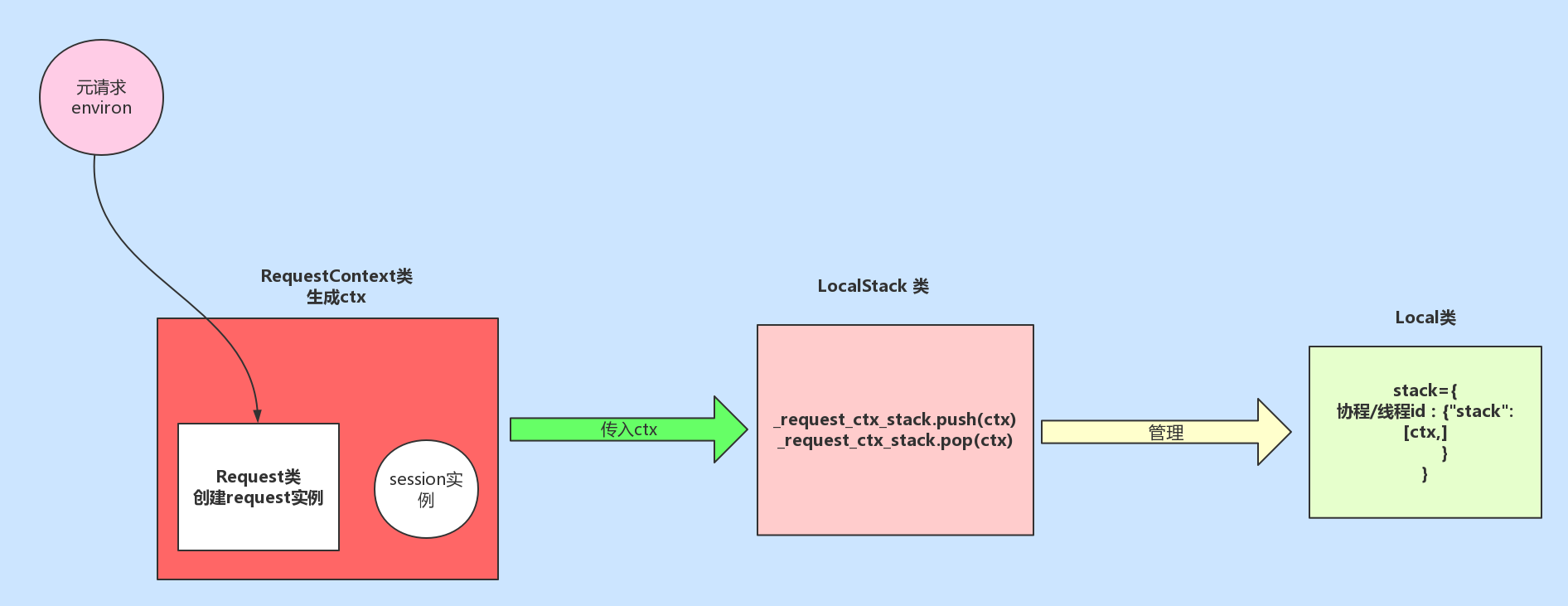1.请求上下文和应用上下文入栈
# 将ctx入栈,但是内部也将应用上下文入栈 ctx.push()
def push(self): # 获取到的 top == ctx top = _request_ctx_stack.top if top is not None and top.preserved: top.pop(top._preserved_exc) # Before we push the request context we have to ensure that there # is an application context. """ _request_ctx_stack 和 _app_ctx_stack 都是 Local 类的实例 """ # 获取 应用上下文的栈顶元素,得到 app_ctx app_ctx = _app_ctx_stack.top if app_ctx is None or app_ctx.app != self.app: # self.app == Fask() # 得到 一个 AppContext类的实例对象,得到一个 应用上下文对象 app_ctx,此时 app_ctx拥有以下属性: app_ctx.app = app, app_ctx.g = app.app_ctx_globals_class() app_ctx = self.app.app_context() # 将 app_ctx 入栈,应用上下文入栈 app_ctx.push() self._implicit_app_ctx_stack.append(app_ctx) else: self._implicit_app_ctx_stack.append(None) if hasattr(sys, 'exc_clear'): sys.exc_clear() # self 指的是 ctx,即将ctx入栈,即 _request_ctx_stack._local.stack = [ctx]。请求上下文入栈 _request_ctx_stack.push(self) # 由于每次请求都会初始化创建你ctx,因此session都为None if self.session is None: # SecureCookieSessionInterface() # session_interface = SecureCookieSessionInterface(),即session_interface就是一个SecureCookieSessionInterface类的实例对象 session_interface = self.app.session_interface # 第一次访问:生成一个 字典(容器) 返回至 self.session self.session = session_interface.open_session( self.app, self.request ) if self.session is None: self.session = session_interface.make_null_session(self.app)
首先,应用上下文入栈,这里不多做解释说明,其执行流程与请求上下文相同,请参考下文对与请求上下文的入栈流程分析。
到_app_ctx_stack这个栈中取最后一个数据,如果未取到或者取到的不是当前的app,就调用app.app_context()方法,就是新实例一个上下文app_ctx对象,再执行app_ctx.push()方法 (在这再次强调,因为app_ctx是AppContext对象,就要先去AppContext类中找push方法),
class AppContext(object): def push(self): _app_ctx_stack.push(self) #把新创建的app_ctx上下文app对象添加到了_app_ctx_stack这个栈中 appcontext_pushed.send(self.app) #在这里遇到了第一个信号,请求app上下文push时执行
其次,请求上下文入栈。执行 _request_ctx_stack.push(self) ,我们先看看 _request_ctx_stack 是什么。由 _request_ctx_stack = LocalStack()
可知 _request_ctx_stack 是 LocalStack 类实例对象,进入 LocalStack 的构造方法中
def __init__(self): self._local = Local()
即在类实例化过程中,为 _request_ctx_stack 实例对象创建 _local 属性,该属性的值是 Local 类实例,进入其构造方法中,在该方法中为每一个 Local 类实例创建 __storage__ 和 __ident_func__ 属性:
class Local(object): __slots__ = ('__storage__', '__ident_func__') def __init__(self): object.__setattr__(self, '__storage__', {}) object.__setattr__(self, '__ident_func__', get_ident)
至此,完成了对 _request_ctx_stack 实例对象创建的流程分析,但是需要注意的是,该实例对象并不是在每次请求之后才创建完成的,而是在flask项目启动之后就会被立即创建,该对象对于每次的请求都会调用该对象的push方法进行请求上下文的入栈,也就是说 _request_ctx_stack 是一个单例对象,该单例对象可以在任何的地方被调用,其他的单例对象还有:
""" 注意: 在项目启动之后,global里的代码就已经执行完毕,而且也只会执行一次,因此这里面的变量是针对所有请求所使用的,但是根据不同线程id用来存放各自的值 """ # 生成 请求上下文栈对象,将请求上下文对象 ctx 保存到 _request_ctx_stack._local.stack = [ctx]中 _request_ctx_stack = LocalStack() # 生成应用上下文栈对象,将应用上下文对象 app_ctx 保存到 _app_ctx_stack._local.stack = [app_ctx]中 _app_ctx_stack = LocalStack() # current_app.__local = app current_app = LocalProxy(_find_app) # 获取ctx.request request = LocalProxy(partial(_lookup_req_object, 'request')) # 获取 ctx.session session = LocalProxy(partial(_lookup_req_object, 'session')) # 维护此次请求的一个全局变量,其实就是一个字典 g = LocalProxy(partial(_lookup_app_object, 'g'))
对于以上的单例对象,在项目启动之后被创建,在项目停止后被销毁,与请求是否进来无任何关系。现在我们知道了 _request_ctx_stack 的创建流程,我们返回之前对请求上下文的入栈操作 _request_ctx_stack.push(self) (self指的是ctx),进入push方法:
def push(self, obj): # obj == ctx """Pushes a new item to the stack""" rv = getattr(self._local, 'stack', None) if rv is None: self._local.stack = rv = [] rv.append(obj) return rv
在上述流程中,首先使用反射获取 _request_ctx_stack._local.stack 的值,也就是获取请求栈的值。项目刚启动,在第一次请求进来之前,请求栈的为空,则代码继续向下执行将当前请求的ctx追加至请求栈中,并且返回请求栈的值。这里着重说一下入栈之前的流程和入栈之后的数据结构:执行 self._local.stack = rv = [] ,会调用 Local 类的 __setattr__ 方法
def __setattr__(self, name, value): ident = self.__ident_func__() storage = self.__storage__ try: storage[ident][name] = valueexcept KeyError: storage[ident] = {name: value}
self.__ident_func__() 为获取当前此次请求的协程id或者线程id, self.__storage__ 为一个字典对象,在项目启动后的第一个请求进来之后会发生 storage[ident][name] = value 的异常错误,抛出异常被下面捕获,因此执行 storage[ident] = {name: value} (以此次协程id或线程id为key,该key的value为一个字典,在字典中存储一个键值对"stack":[ctx]),即此数据结构为:
_request_ctx_stack._local.stack={ 线程id或协程id: { 'stack': [ctx] } }
同时, self._local.stack = [ctx]。至此,完成请求上下文的入栈操作,应用上下文与请求上下文的入栈流程相同,这里不在赘述。至此完成了请求入栈的操作,我们需要知道在上述过程中使用到的四个类: RequestContext (请求上下文类,实例对象ctx中包含了request,Session两个属性)、
Request (对请求的元信息environ进行封装)、 LocalStack (使用该类实例对象 _request_ctx_stack ,维护请求上下文对象ctx的入栈和出栈操作,相当于请求上下文对象的管理者)、 Local (堆栈类,真正存放请求上下文的类),如果你还是对着几个类关系还是不明白,请看我为你准备的图:

2. ctx.auto_pop(error) 函数,完成对请求上下文和应用上下文的出栈操作:
# 出栈,删除本次请求的相关信息 ctx.auto_pop(error)
def auto_pop(self, exc): if self.request.environ.get('flask._preserve_context') or (exc is not None and self.app.preserve_context_on_exception): self.preserved = True self._preserved_exc = exc else: self.pop(exc)
def pop(self, exc=_sentinel): """Pops the request context and unbinds it by doing that. This will also trigger the execution of functions registered by the :meth:`~flask.Flask.teardown_request` decorator. .. versionchanged:: 0.9 Added the `exc` argument. """ app_ctx = self._implicit_app_ctx_stack.pop() try: clear_request = False if not self._implicit_app_ctx_stack: self.preserved = False self._preserved_exc = None if exc is _sentinel: exc = sys.exc_info()[1] self.app.do_teardown_request(exc) # If this interpreter supports clearing the exception information # we do that now. This will only go into effect on Python 2.x, # on 3.x it disappears automatically at the end of the exception # stack. if hasattr(sys, 'exc_clear'): sys.exc_clear() request_close = getattr(self.request, 'close', None) if request_close is not None: request_close() clear_request = True finally: # 请求上下文出栈 rv = _request_ctx_stack.pop() # get rid of circular dependencies at the end of the request # so that we don't require the GC to be active. if clear_request: rv.request.environ['werkzeug.request'] = None # Get rid of the app as well if necessary. if app_ctx is not None: # 应用上下文出栈 app_ctx.pop(exc) assert rv is self, 'Popped wrong request context. ' '(%r instead of %r)' % (rv, self)
def pop(self): """Removes the topmost item from the stack, will return the old value or `None` if the stack was already empty. """ stack = getattr(self._local, 'stack', None) if stack is None: return None elif len(stack) == 1: release_local(self._local) return stack[-1] else: # 获取并删除列表中的第一个元素,同时返回该元素 return stack.pop()
stack获取到的是请求栈或应用栈的列表,栈的长度为1,则进入 elif 控制语句中,首先执行 release_local(self._local) :
def release_local(local): local.__release_local__()
local=self._local ,即执行 Local 类的 __release_local__ 方法,进入该方法:
def __release_local__(self): # 将 self.__storage__ 所维护的字典中删除当前协程或线程id为key的元素 self.__storage__.pop(self.__ident_func__(), None)
从上面的语句中可以很明显看出,要执行的操作就是将以当前协程或线程id为key的元素从字典 self.__storage__ 中删除,返回至pop函数中的elif控制语句,最终将列表中的最后一个元素返回。注意,最终 _request_ctx_stack._local 的请求栈和应用栈列表中至少会存在一个元素。